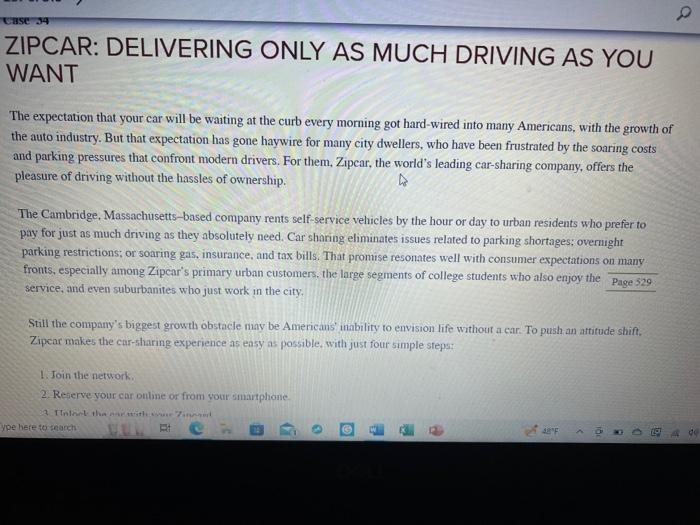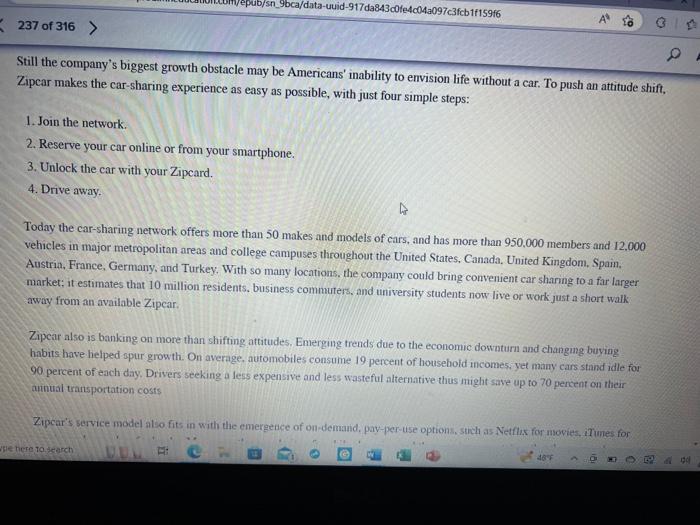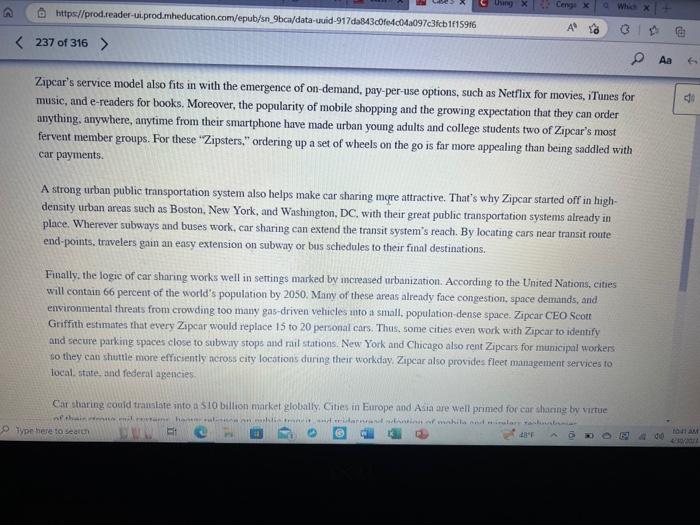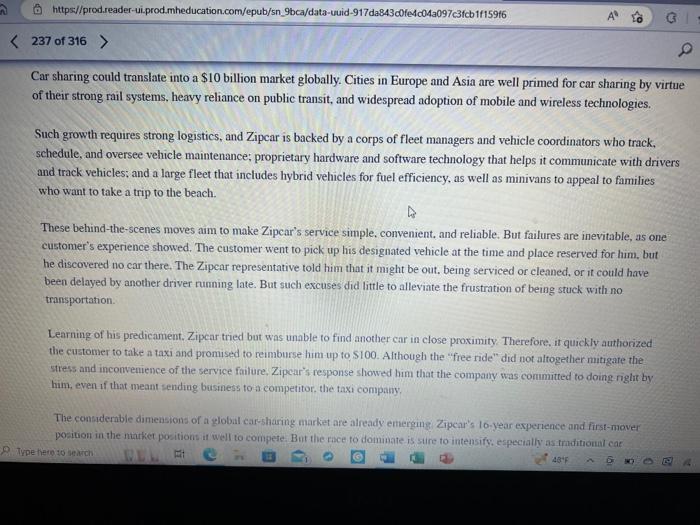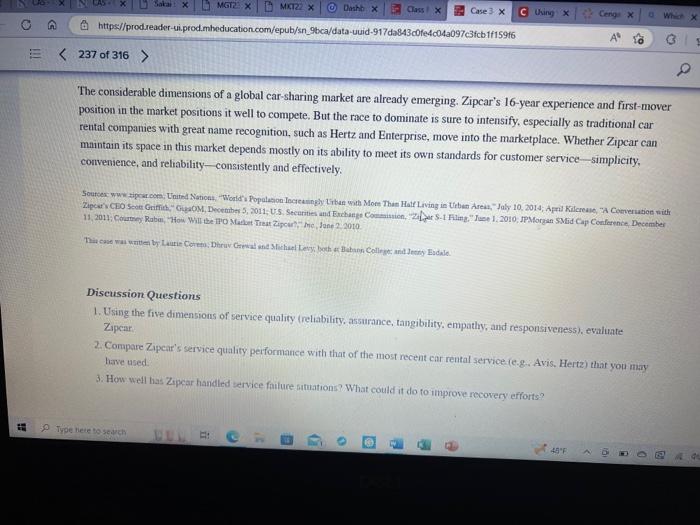The expectation that your car will be waiting at the curb every morning got hard-wired into many Americans, with the growth of the auto industry. But that expectation has gone haywire for many city dwellers, who have been frustrated by the soaring costs and parking pressures that confront modern drivers. For them, Zipcar, the world's leading car-sharing company, offers the pleasure of driving without the hassles of ownership. The Cambridge, Massachusetts-based company rents self-service velicles by the hour or day to urban residents who prefer to pay for just as much driving as they absolutely need. Car sharing eliminates issues related to parking shortages; overuight parking restrictions; or soaring gas, insurance, and tax bills. That promise resonates well with consumer expectations on many fronts, especially among Zipcar's primary urban customers. the large segments of college students who also enjoy the service, and even suburbanites who just work in the city. Still the company's biggest growth obstacle may be Americans inability to envision life without a car. To push an attifude shift. Zipcar makes the car-sharing experience as ensy as possible, with just four simple steps: 1. Join the network. 2. Reserve your car onbine or from your smartphone Still the company's biggest growth obstacle may be Americans' inability to envision life without a car. To push an attitude shift. Zipcar makes the car-sharing experience as easy as possible, with just four simple steps: 1. Join the network: 2. Reserve your car online or from your smartphone. 3. Unlock the car with your Zipcard. 4. Drive away. Today the car-sharing network offers more than 50 makes and models of cars, and has more than 950,000 members and 12,000 vehicles in major metropolitan areas and college campuses throughout the United States, Canada, United Kingdom, Spain. Austria, France, Germany, and Turkey. With so many locations, the company could bring convenient car sharing to a far larger market; it estimates that 10 million residents. business commuters, and university students now live or work just a short walk away from an available Zipcar. Zipear also is banking on more than shifting attitudes. Emerging trends due to the economic downturn and changmg buying habits have helped opur growth. On average, automobiles consume 19 percent of household incomes, yet many cars stand idle for 90 percent of each day. Drivers seeking a less expensive and less wasteful alternative thus might save up to 70 perceat on thicir aunual transportation costs Zipcar's service model also fits in with the emergence of on-demand, pay-per-ise options, stich as Netflis for movies, iTumes for Zipcar's service model also fits in with the emergence of on-demand, pay-per-use options, such as Netflix for movies, iTunes for music, and e-readers for books. Moreover, the popularity of mobile shopping and the growing expectation that they can order anything, anywhere, anytime from their smartphone have made urban young adults and college students two of Zipcar's most fervent member groups. For these "Zipsters," ordering up a set of wheels on the go is far more appealing than being saddled with car payments. A strong urban public transportation system also helps make car sharing mqre attractive. That's why Zipcar started off in highdensity urban areas such as Boston, New York, and Washington, DC. with their great public transportation systems already in place. Wherever subways and buses work, car sharing can extend the transit system's reach. By locating cars near transit route end-points, travelers gain an easy extension on subway or bus schedules to their final destinations. Finally, the logic of car sharing works well in settings marked by increased urbanization. According ro the Lnited Nations, cities will contain 66 percent of the world's population by 2050 . Mamy of these areas already face congestion, space demands, and environmental threats from crowding too many gas-driven vehicles anto a small, population-dense space. Zipcar CEO Scott Griffith estimates that every Zipcar would replace 15 to 20 personal cars. Thus. some cities even work with Zipcar to identify and secure parking spaces close to subway stops and mil stations. New York and Chicago also rent Zipcars for mumicipal workers to they can shutile more efficiently ncross city locations during their workday. Zipcar also provides fleer mamagement services to local. state, and federal agencies. Car sharing could translate into a $10 billion market globally. Cities in Europe and Asia are well primed for car sharing by virtue of their strong rail systems, heavy reliance on public transit, and widespread adoption of mobile and wireless technologies. Such growth requires strong logistics, and Zipcar is backed by a corps of fleet managers and vehicle coordinators who track, schedule, and oversee vehicle maintenance; proprietary hardware and software technology that helps it communicate with drivers and track vehicles; and a large fleet that includes hybrid vehicles for fuel efficiency, as well as minivans to appeal to families who want to take a trip to the beach. These behind-the-scenes moves aim to make Zipcar's service simple. convenient, and reliable. But failures are inevitable, as one customer's experience showed. The customer went to pick up his designated vehicle at the time and place reserved for him, but he discovered no car there. The Zipear representative told him that it might be out, being serviced or cleaned, or it could have been delayed by another driver rumning late. But such excuses did little to alleviate the frustration of being stuck with no transportation. Learning of his predicament. Zipcar tried but was unable to find another car in close proximity. Therefore. it quickly authorized the customer to take a taxi and promised to reimburse him up to $100. Although the "free ride" did not altogether mitigate the stress and inconvenience of the service failure, Zipear's response showed him that the company was committed to doing righti by him, even if that meant sending business to a competitor, the taxi company. The consderable dimensions of a global car-sharing market are already emergmg Zipcur's 10-year experience and first-mover position in the nutrke positions it well to compere. But the moe to dominate is sire to intensify, expecially as traditional cat The considerable dimensions of a global car-sharing market are already emerging. Zipcar's 16-year experience and first-mover position in the market positions it well to compete. But the race to dominate is sure to intensify, especially as traditional car rental companies with great name recognition, such as Hertz and Enterprise, move into the marketplace. Whether Zipcar can maintain its space in this market depends mostly on its ability to meet its own standards for customer service-simplicity. convenience, and reliability - consistently and effectively. Discussion Questions 1. Using the five dimensions of service quality (reliability, assurance, tangibility, empathy, and responsiveness), evaluate Zipcar. 2. Compare Zipear's service quality performance with that of the most recent car rental service (e.8. Avis. Hertz) that your may have used 3. How well has Zipcar handled zervice fillure sumations? What could it do fo improve recovery efforts? 1, 2011; Courtney Rubin, "How Will the IPO Market Treat Zipcan?," Inc, June 2, 2010. Thin case was written by Laurie Covens; Dhruv Grewal and Michael Levy, both at Babson Cotlege; and Jenny Esdale. Discussion Questions 1. Using the five dimensions of service quality (reliability, assurance, tangibility, empathy, and responsiveness), evaluate Zipcar. 2. Compare Zipcar's service quality performance with that of the most recent car rental service (e.g., Avis, Hertz) that you ma have used. 3. How well has Zipcar handled service failure situations? What could it do to improve recovery efforts
